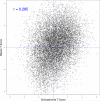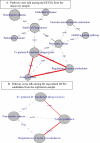Transcriptome sequencing and genome-wide association analyses reveal lysosomal function and actin cytoskeleton remodeling in schizophrenia and bipolar disorder
- PMID: 25113377
- PMCID: PMC4326626
- DOI: 10.1038/mp.2014.82
Transcriptome sequencing and genome-wide association analyses reveal lysosomal function and actin cytoskeleton remodeling in schizophrenia and bipolar disorder
Abstract
Schizophrenia (SCZ) and bipolar disorder (BPD) are severe mental disorders with high heritability. Clinicians have long noticed the similarities of clinic symptoms between these disorders. In recent years, accumulating evidence indicates some shared genetic liabilities. However, what is shared remains elusive. In this study, we conducted whole transcriptome analysis of post-mortem brain tissues (cingulate cortex) from SCZ, BPD and control subjects, and identified differentially expressed genes in these disorders. We found 105 and 153 genes differentially expressed in SCZ and BPD, respectively. By comparing the t-test scores, we found that many of the genes differentially expressed in SCZ and BPD are concordant in their expression level (q⩽0.01, 53 genes; q⩽0.05, 213 genes; q⩽0.1, 885 genes). Using genome-wide association data from the Psychiatric Genomics Consortium, we found that these differentially and concordantly expressed genes were enriched in association signals for both SCZ (P<10(-7)) and BPD (P=0.029). To our knowledge, this is the first time that a substantially large number of genes show concordant expression and association for both SCZ and BPD. Pathway analyses of these genes indicated that they are involved in the lysosome, Fc gamma receptor-mediated phagocytosis, regulation of actin cytoskeleton pathways, along with several cancer pathways. Functional analyses of these genes revealed an interconnected pathway network centered on lysosomal function and the regulation of actin cytoskeleton. These pathways and their interacting network were principally confirmed by an independent transcriptome sequencing data set of the hippocampus. Dysregulation of lysosomal function and cytoskeleton remodeling has direct impacts on endocytosis, phagocytosis, exocytosis, vesicle trafficking, neuronal maturation and migration, neurite outgrowth and synaptic density and plasticity, and different aspects of these processes have been implicated in SCZ and BPD.
Figures



Similar articles
-
Transcriptome analysis of cortical tissue reveals shared sets of downregulated genes in autism and schizophrenia.Transl Psychiatry. 2016 May 24;6(5):e817. doi: 10.1038/tp.2016.87. Transl Psychiatry. 2016. PMID: 27219343 Free PMC article.
-
Commonality in dysregulated expression of gene sets in cortical brains of individuals with autism, schizophrenia, and bipolar disorder.Transl Psychiatry. 2019 May 24;9(1):152. doi: 10.1038/s41398-019-0488-4. Transl Psychiatry. 2019. PMID: 31127088 Free PMC article.
-
Aberrant transcriptomes and DNA methylomes define pathways that drive pathogenesis and loss of brain laterality/asymmetry in schizophrenia and bipolar disorder.Am J Med Genet B Neuropsychiatr Genet. 2019 Mar;180(2):138-149. doi: 10.1002/ajmg.b.32691. Epub 2018 Nov 23. Am J Med Genet B Neuropsychiatr Genet. 2019. PMID: 30468562 Free PMC article.
-
Genetic evidence for role of integration of fast and slow neurotransmission in schizophrenia.Mol Psychiatry. 2017 Jun;22(6):792-801. doi: 10.1038/mp.2017.33. Epub 2017 Mar 28. Mol Psychiatry. 2017. PMID: 28348379 Free PMC article. Review.
-
Bipolar disorder and schizophrenia: convergent molecular data.Neuromolecular Med. 2004;5(1):109-17. doi: 10.1385/NMM:5:1:109. Neuromolecular Med. 2004. PMID: 15001816 Review.
Cited by
-
Discovery and characterization of long intergenic non-coding RNAs (lincRNA) module biomarkers in prostate cancer: an integrative analysis of RNA-Seq data.BMC Genomics. 2015;16 Suppl 7(Suppl 7):S3. doi: 10.1186/1471-2164-16-S7-S3. Epub 2015 Jun 11. BMC Genomics. 2015. PMID: 26100580 Free PMC article.
-
Consistently altered expression of gene sets in postmortem brains of individuals with major psychiatric disorders.Transl Psychiatry. 2016 Sep 13;6(9):e890. doi: 10.1038/tp.2016.173. Transl Psychiatry. 2016. PMID: 27622934 Free PMC article.
-
EW_dmGWAS: edge-weighted dense module search for genome-wide association studies and gene expression profiles.Bioinformatics. 2015 Aug 1;31(15):2591-4. doi: 10.1093/bioinformatics/btv150. Epub 2015 Mar 24. Bioinformatics. 2015. PMID: 25805723 Free PMC article.
-
Proteomic and Microscopic Strategies towards the Analysis of the Cytoskeletal Networks in Major Neuropsychiatric Disorders.Int J Mol Sci. 2016 Apr 20;17(4):581. doi: 10.3390/ijms17040581. Int J Mol Sci. 2016. PMID: 27104521 Free PMC article. Review.
-
Translational bioinformatics in mental health: open access data sources and computational biomarker discovery.Brief Bioinform. 2019 May 21;20(3):842-856. doi: 10.1093/bib/bbx157. Brief Bioinform. 2019. PMID: 29186302 Free PMC article. Review.
References
-
- Sheng G, Demers M, Subburaju S, Benes FM. Differences in the circuitry-based association of copy numbers and gene expression between the hippocampi of patients with schizophrenia and the hippocampi of patients with bipolar disorder. Arch Gen Psychiatry. 2012;69:550–561. - PubMed
-
- Karege F, Meary A, Perroud N, Jamain S, Leboyer M, Ballmann E, et al. Genetic overlap between schizophrenia and bipolar disorder: a study with AKT1 gene variants and clinical phenotypes. Schizophr Res. 2012;135:8–14. - PubMed
-
- Williams HJ, Craddock N, Russo G, Hamshere ML, Moskvina V, Dwyer S, et al. Most genome-wide significant susceptibility loci for schizophrenia and bipolar disorder reported to date cross-traditional diagnostic boundaries. Hum Mol Genet. 2011;20:387–391. - PubMed
Publication types
MeSH terms
Grants and funding
LinkOut - more resources
Full Text Sources
Other Literature Sources
Medical

